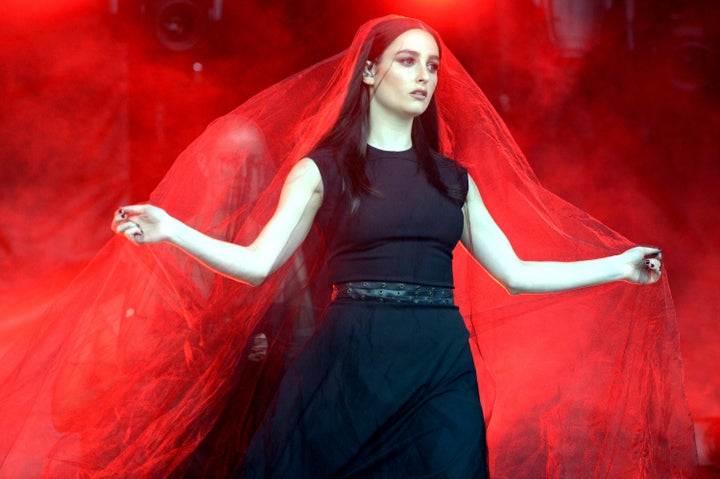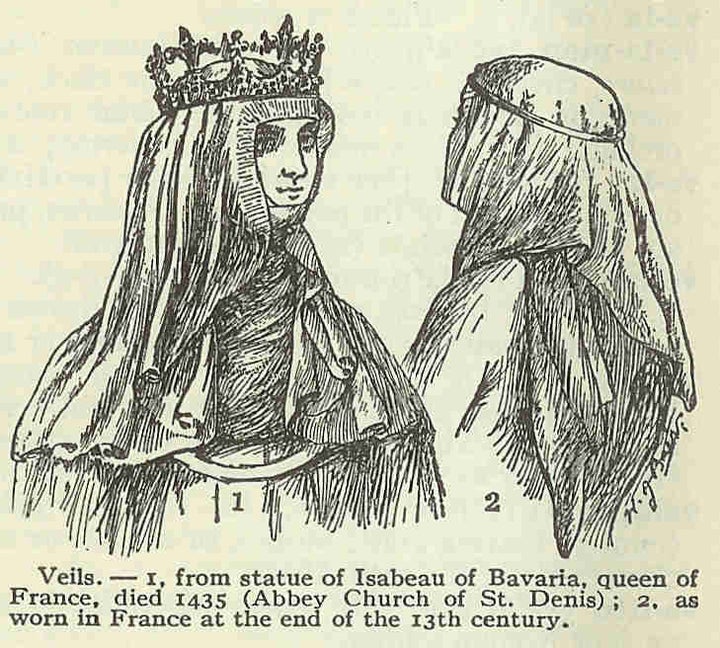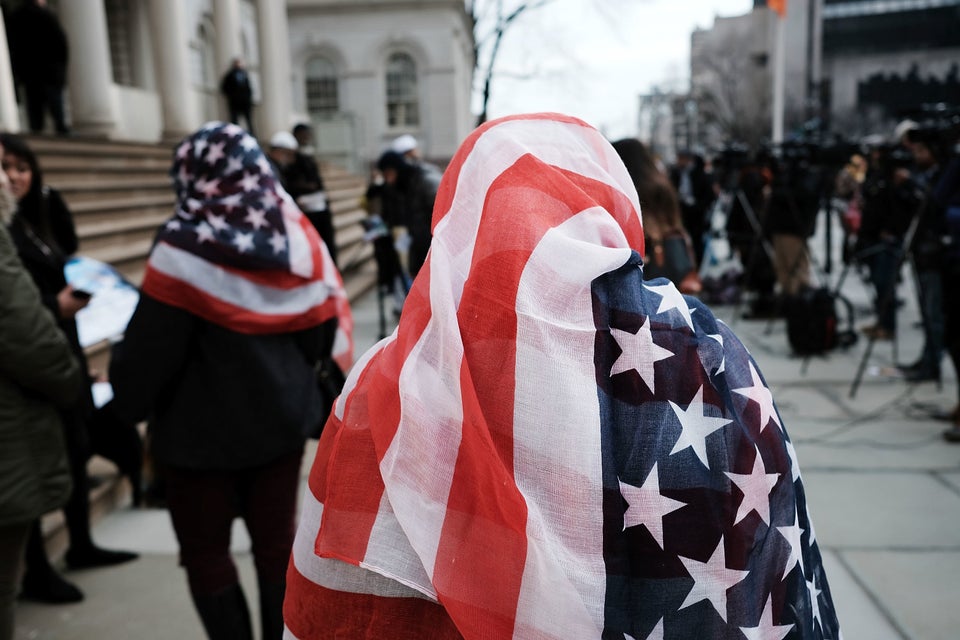During a performance at Glastonbury Festival last year, dream pop singer Natasha Khan, better known as Bat for Lashes, emerged onstage wearing a white, floor-length wedding gown and a veil to match. Her movements appeared muffled, ritualistic, almost ghostlike, as if she was Miss Havisham singing karaoke to a packed house. “But what does it mean?” Khan sang. “The bad things that I’ve seen.” Slowly and purposefully she pulled the veil back from her face. The crowd cheered at the great reveal.
In his essay “Ways of Seeing,” art critic John Berger argues that “men act and women appear,” that being seen is a fundamental and perpetual element of the feminine experience. “Men look at women. Women watch themselves being looked at,” he wrote.
There are many ways to disrupt this stereotypical relationship between the man who watches and the woman who’s watched, and one time-tested method is donning a veil, a cascading mask that separates the wearer from the world. Veils hold centuries of symbolic references in their folds, stemming from a variety of cultures and religions. In the past couple of years, they’ve made a peculiar resurgence on the pop culture scene, as female musicians in pop, R&B and hip-hop have cloaked their faces in dripping fabric, both in videos and on stage. Musicians like Bat for Lashes, Banks, Princess Nokia, Beyonce and SZA have each resuscitated and warped the garment’s storied associations with femininity, the sacred and the profane.
On her 2016 album “The Bride,” Bat for Lashes assumes the identity of a fictitious, lovesick bride whose groom-to-be dies in a car crash en route to their wedding. In the record’s first song, “I Do,” Khan revels in the fantasy of marital bliss that so many young women indulge. Yet by the third song, “In God’s House,” the groom hasn’t shown up and Khan knows something has gone horribly awry. “Through this veil they can’t see / The fog of death envelop me,” she sings.
In the video for the song, Khan wears an infrared cocktail dress with a retro veil and a caramel fur coat. She treks through a desolate desert landscape to visit a shrine to her late fiancé. As the sky turns violet, Khan removes her veil and waves it above her head, the tulle trembling in the wind. At times the fabric blocks the camera’s lens, clouding the viewer’s perspective in a red haze. The scene couples the veil’s nuptial duties with another of its more macabre functions ― as a symbol of mourning.
In a single album, Khan explores the veil’s knotted relationship with betrothal and independence, morality and mortality, love and death. These symbolic associations are prevalent in Western culture today; brides often don a white veil as a symbol of chastity and virginity, which the groom peels back as part of the marriage ceremony. Alternately, black veils serve as a marker of grief, providing the mourner a semblance of privacy.
One of the earliest written references to veils is found in Middle Assyrian law code, written between 1400 and 1100 BCE, which describes the accessory’s purpose: to distinguish women who were “respectable” ― and thus should be hidden from view ― from those who weren’t. In Ancient Greece and Rome, married women similarly wore veils to visualize their subservience to their husbands. Thousands of years have passed and veils have retained their relevance. Some Muslim women ― and, to a lesser degree, men ― wear veils as symbols of modesty and privacy, a layer to separate the self from the divine, a practice similar to those of devout Jewish and Christian communities.
Regardless of cultural and religious specifics, though, veils are most often reserved for women, whether their beauty is considered too sacred for everyday life, or too profane.

For Khan, the veil makes the bride; removing it becomes an act of liberation. Yet other artists opt to contort the veil’s symbolic reference points, taking comfort in its coverage as a sort of disguise. Singer-songwriter Banks, for example, incorporates sheer black veils into her performances and music videos ― specifically, veils that resemble those worn by Isis, an ancient Egyptian goddess of fertility. Banks rarely performs in anything other than all black, yielding a witchy aesthetic that appeals to young women seeking power beyond patriarchal structures.
“And to think you would get me to the altar,” Banks sings on her second album, appropriately titled “The Altar,” patronizing an ex-lover who, she sings, kept a limiting grip on her.
In this verse, Banks uses altar as a stand-in for wedding. Yet as an album title, the follow-up to her debut “Goddess,” “altar” takes on a more ambiguous, occult tenor. The altar transforms from a site of marriage to a grander space for worship ― likely, worship of Banks, the goddess herself. And so does the veil. When Banks emerges onstage draped in black gauze, powerful and stormy, she recalls the image of a pristine bride only to contradict it completely. Rather than removing her wedding sheath, she dyes it black and writhes beneath it, scorning those who hindered her growth. She adopts the veil as a sort of mask, containing a wearer with a spiritual force so powerful it must be buffered. She becomes the goddess of Isis, a creature defined by mystery and power.
Another artist to weave references to altars, veils and spirituality into her music and performances is rapper Princess Nokia. In her recently released video for “Brujas,” a woman stands in the ocean draped in a turquoise veil, an homage to Yemayá, a figure in Santería and Yoruba religions, who, as the mystical queen of the sea, represents motherhood. Her arms undulate like the water as singer Djali Cepeda Brown sings an indigenous song as introduction. Then the beat kicks in with the syrupy incantation: “I’m your supreme, I’m your supreme.”
Nokia’s verses pay homage to womanhood, witchcraft and her Afro-Latina heritage. “We is them ghetto witches,” she begins. “Speaking in tongue bitches / Fall on the floor / Got sage on the door.” Like Banks, Nokia aligns the veil with an occult tradition, though hers is tethered to the Yoruba. Her chorus declares, “Orisha, my altar / Got coins on the counter,” referencing the religion’s Supreme Divinity.
Of course, in the world of pop culture, most music fans worship at the altar of Beyonce. It’s not surprising, then, that one of the most iconic veils in recent pop cultural memory was worn when the queen announced her pregnancy back in February. Beyonce wore a transparent sea foam green veil with a bra and boy shorts in a now legendary photograph by Awol Erizku. It didn’t take long after the picture spread for art critics to draw comparisons between the singer’s blueish veil and that worn by the Virgin Mary in countless art historical representations.
Fabric and cloth, and the very act of sewing, are symbols central to Mary’s role in the Bible, summarized by the belief that, in giving birth to Jesus, she “gave the divine a bodily form in which to cloth itself on earth.” To this day, the Veil of the Virgin is deemed a Christian relic with great significance. The shroud represents meekness and humility, but also, motherhood and the immense power possessed within it. When, after giving birth to twins, Beyonce shared a photo of them for the first time, she again sported an aquamarine veil, though this time the tissue was pulled back to reveal her face. At the 2017 Grammy’s, Beyonce wore another veil ― this one opaque, beaded and gold. The look combines Catholic iconography with references to Yoruba tradition, blurring the line between belief systems to conjure a stirring image of matriarchal power.
Today, weddings aside, Muslim women are the most prominent group to incorporate veils into their everyday lives. The hijab ― one manifestation of the veil, along with niqab, burqa, abaya, khimar, chador ― is described in the Quran “not as an article of clothing but something akin to a curtain or ‘separation’ that allows for privacy,” according to The New York Times.
R&B singer SZA rocked a veil (though, none of the veils or headscarves listed above) in the music video for her song “Drew Barrymore,” an ode to the ’90s romcom heroine. Singing the song’s chorus in a laundromat, SZA wears a baby pink fishnet shroud tucked beneath a broad-brimmed purple hat. Aside from these accessories, she dons only high-heeled shoes as she kneels, curling her body into a ball, apparently recreating a Mark-Meir Paluksht photograph.
SZA grew up, as she described, “orthodox Muslim. Very sheltered, very conservative.” She wore a hijab until 9/11, when Islamophobia spread amongst her classmates and led to taunting and bullying at school. “At school, I wanted to fit in so I would take my hijab off,” she told Complex in 2013. “I asked my mom if I could go school shopping, rather than let my dad because I would just wear long skirts or overalls everyday.”
In her video, SZA is nude, a stark shift from the modest dress code expected of many observant Muslim women. And yet the veil remains, a symbol of her faith, executed without apology or compromise. Whether or not SZA’s outfit choice self-consciously pays tribute to her Muslim upbringing, there is something undeniably powerful about its presence, and little else.

It’s a curious time for veils to reemerge so strongly in pop culture, given the increase in hostility and violence toward Muslim women who wear headscarves for religious purposes. It feels off when certain women don veils and set trends, while others risk their safety doing the same. But on a certain level, pop culture has always served as a safe space for a select few to enact the daily fears and fantasies of the rest of us.
Let’s return, then, to Berger’s words ― “men act and women appear” ― not as an insurmountable truth but a widespread belief. By Berger’s logic, men paint and women are painted; men are artists, women muses. Yet while Renaissance painters may have been able to work hidden from view, for contemporary musicians, being seen is an integral part of making art. By donning veils, female artists both erase and illuminate their own visibility, emphasizing the power of their image that can enchant, seduce and inspire.
“Women constantly meet glances which act like mirrors reminding them of how they look or how they should look,” Berger writes. “Behind every glance there is judgment.” The veil disrupts this expectation, denying the male viewer the opportunity to judge the female artist, freeing her up to act as well as to appear. And to embrace the power in both.

